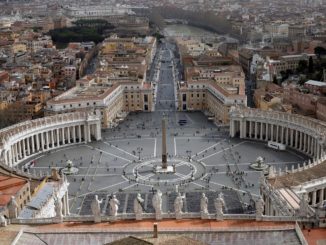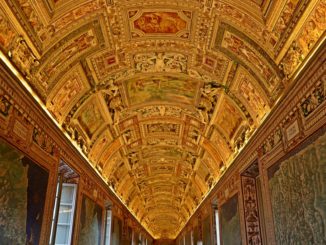
“An Authentic and Renewed Conversion”
During this Year of Faith, we are invited to rediscover the challenge and adventure of the journey of faith through “an authentic and renewed conversion” of mind and heart to Christ (Pope Benedict XVI, Porta Fidei, no. 6). The word “conversion” comes from a Greek word metanoia, which means “change of life” or “change of perspective.” So we members of the Church – who already call ourselves Christians and believers – are called to change our ways of thinking and living so that they conform more closely to those of Christ and His Gospel. Conversion is necessarily an ongoing, lifelong process because we are weak, sinful human beings who often fail to live up to our vocation as Christians. Moreover, our faith in Christ tends to grow weak as we allow our ways of thinking and living to be (often unconsciously and gradually) corrupted by the anti-Christian attitudes of the world in which we live. Thus in order to remain strong in our faith, we must constantly be turning towards Christ, renewing our commitment to follow Him faithfully, and allowing our ways of thinking and living to be shaped by his Gospel. Saint Paul reminds us: “Do not conform to yourselves to this age but be transformed by the renewal of your mind, that you may discern what is the will of God, what is good and pleasing and perfect” (Rom. 12: 2). “Have among yourselves the same attitude that is also yours in Christ Jesus” (Phil. 2: 5).
Being a disciple of Christ means first of all believing that He is the Son of God, but it also means listening to His teachings, obeying His commands, and following His example. In his many teachings recorded in the Gospels, Christ makes it clear that authentic discipleship is not merely an intellectual exercise of belief in Him; it is an ongoing personal relationship with Him, and it demands certain things of us. Faith in Christ is necessary for salvation, but (contrary to the claim of Protestant reformer Martin Luther) “faith alone” is an unbiblical concept and insufficient for salvation. Our faith must be put into action, or else it is useless. “Faith of itself, if it does not have works, is dead” (Jas. 2:17).
Recent Popes have observed that an unacceptable gap often exists between what we Catholics believe and how we live our daily lives. While we call ourselves Christians, our faith in Christ is often superficial and compartmentalized, failing to profoundly affect our whole lives as it should. A convincing case could probably be made that most of the great evils of the twentieth century had their origin in the failure of Catholics to properly live out their faith; moreover, such failure is partly to blame for the current crisis of faith in the modern world. When Christian believers act in a manner contrary to the demands of the Gospel, they betray Christ and his Church, give scandal to fellow Christians and discredit the faith in the eyes of nonbelievers. The Year of Faith is a reminder to all of us followers of Christ that what we believe and how we live must go together in a single, harmonious whole.
The blessed in Heaven, those who followed Christ faithfully on earth throughout the past twenty centuries, are our role models for how to live the Christian journey of faith. In a special way, the Church holds up for our imitation the Blessed Virgin Mary, the Mother of Christ and of the church, she who was called “blessed because she believed” (Lk. 1:45), as the perfect model of Christian discipleship. Pope Benedict also called Mary “the Mother of Missionaries” because she was the first person to joyfully share her experience of Christ with someone else when, after having conceived him in her womb, she traveled to visit her relative Elizabeth (cf. Lk. 1 : 39-56). In our own time, Blessed Mother Teresa of Calcutta and Blessed John Paul II gave us powerful examples of what persons authentically and totally converted to Christ and His Gospel could accomplish for the Church and the world. The secret to their spectacular success is that they were unafraid to allow the full potential of the Christian faith to be unleashed in their lives. They were not perfect human beings, but they were constantly aware of their need for repentance and conversion, constantly renewing their commitment to Christ. We should cultivate our friendship with these members of the Church Triumphant in the Communion of Saints; their witness and intercession should inspire and encourage us as we walk the journey of faith.
Vatican II and the Year of Faith
The primary objective of the Second Vatican Council was to preserve and hand on the deposit of faith. According to Benedict XVI, the timing of the Year of Faith to coincide with the fiftieth anniversary of the opening of Vatican II provides an opportunity to help people better understand and appreciate the great potential of the Council and its documents for the renewal of the Church today . In Porta Fidei, quoting his great predecessor, Benedict maintained:
… the texts bequeathed by the Council Fathers, in the words of Blessed John Paul II, “have lost nothing of their value or brilliance. They need to be read correctly, to be widely known and taken to heart as important and normative texts of the Magisterium, within the Church’s tradition … I feel more than ever in duty bound to point to the Council as the great grace bestowed on the Church in the twentieth century: there we find a sure compass by which to take our bearings in the century now beginning. “
John Paul and Benedict emphasized that the conciliar documents must be properly read and understood if they are to bear the fruit intended by the Council Fathers. Although they do contain pastoral instructions and guidelines, the documents of Vatican II are first and foremost official dogmatic (teaching) documents of the Church’s Magisterium, having been written by the Catholic bishops of the world in union with the Successor of Saint Peter and under the guidance of the Holy Spirit. Thus the texts must be accepted by all Catholics in obedience to the authority of the Church; the doctrines they contain – even those not infallibly proclaimed – are binding on all the faithful.
Due to incorrect interpretation and implementation of the Council in the decades following it, Vatican II and its documents have often been misconstrued as a radical break with the Church’s tradition, when in fact they are an organic growth and development of that tradition. None of the Council documents contain new teachings; They merely re-enunciate, synthesize, and develop further what the Church has always believed and taught, and thus are meant to be read and understood within the context of the Church’s 2,000-year tradition.



